a pear tree
Deborah Silver is an accomplished and experienced landscape and garden designer whose firm first opened its doors in 1986.
a pear tree
 Regular readers of my essays know I have a big love for boxwood. This fairly small and very dense growing evergreen shrub is as versatile as any plant it has been my pleasure to plant. It is tolerant of a wide variety of soil conditions, and it is quite shade tolerant. Its natural growth is charmingly shaggy. It is more than tolerant of pruning-that is, pruning into shapes. Long hedges. Curving and scrolling hedges. Spheres, squares, rectangles, pyramids trapezoids and triangles-boxwood tolerates this too. Boxwood hardy in my zone is also hardy in pots-provided they get proper water and drainage. Boxwood is just about the most obliging plant material on the planet-for those gardeners that are as interested in design as they are in plants.
Regular readers of my essays know I have a big love for boxwood. This fairly small and very dense growing evergreen shrub is as versatile as any plant it has been my pleasure to plant. It is tolerant of a wide variety of soil conditions, and it is quite shade tolerant. Its natural growth is charmingly shaggy. It is more than tolerant of pruning-that is, pruning into shapes. Long hedges. Curving and scrolling hedges. Spheres, squares, rectangles, pyramids trapezoids and triangles-boxwood tolerates this too. Boxwood hardy in my zone is also hardy in pots-provided they get proper water and drainage. Boxwood is just about the most obliging plant material on the planet-for those gardeners that are as interested in design as they are in plants.
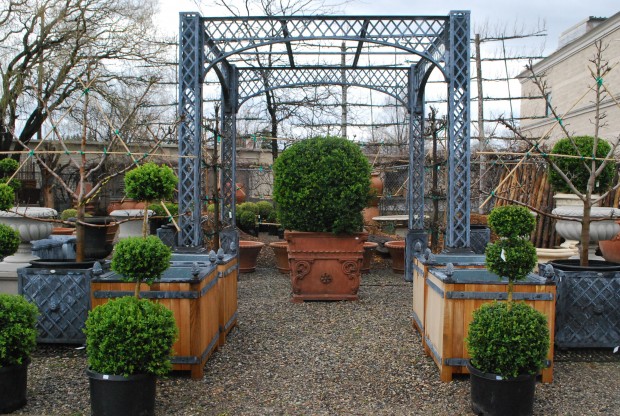 Boxwood flowers are tiny, and anything but showy. The leaves are quite small and unprepossessing. The texture the mass of leaves make-interesting and lively enough. Not massive and sculptural, like the leaves of ligularia, petasites, gunnera, rodgersia or alocasia. Quietly textured. Where boxwood shines has to do with volume, mass, and shape. A hedge of boxwood is satisfyingly regular and pleasing-no matter whether the hedge is natural and shaggy, or closely cropped. A mass of multiple boxwood plants can create shapes of great visual interest. That mass can be pruned flat-like a sheetcake. That mass could be pruned on an angle, or in undulating waves. That mass could narrow at one end, and wide at the other. Boxwood will oblige-whether the landscape design is crispy contemporary, or unabashedly traditional.
Boxwood flowers are tiny, and anything but showy. The leaves are quite small and unprepossessing. The texture the mass of leaves make-interesting and lively enough. Not massive and sculptural, like the leaves of ligularia, petasites, gunnera, rodgersia or alocasia. Quietly textured. Where boxwood shines has to do with volume, mass, and shape. A hedge of boxwood is satisfyingly regular and pleasing-no matter whether the hedge is natural and shaggy, or closely cropped. A mass of multiple boxwood plants can create shapes of great visual interest. That mass can be pruned flat-like a sheetcake. That mass could be pruned on an angle, or in undulating waves. That mass could narrow at one end, and wide at the other. Boxwood will oblige-whether the landscape design is crispy contemporary, or unabashedly traditional.
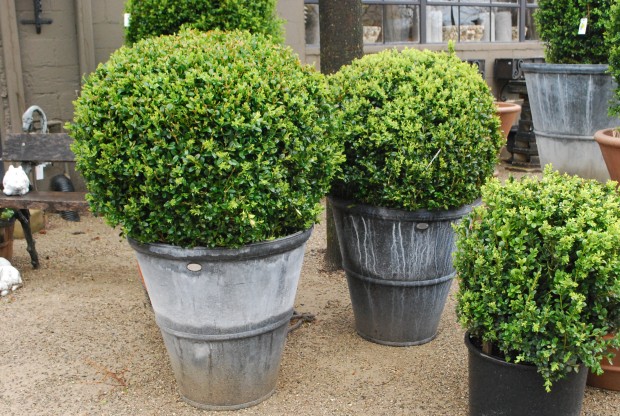 Boxwood grown over a period of time can be shaped into specimen plants-the hallmark of which is the evidence of the pruning hand of a gardener. Pruned boxwood in traditional forms and shapes dates back centuries. Pruned boxwood with a decidedly modern shape-equally as compelling. Why am I so interested in the shapes, the mass, the volume and the texture of boxwood? I am as interested in design as I am interested in plants.
Boxwood grown over a period of time can be shaped into specimen plants-the hallmark of which is the evidence of the pruning hand of a gardener. Pruned boxwood in traditional forms and shapes dates back centuries. Pruned boxwood with a decidedly modern shape-equally as compelling. Why am I so interested in the shapes, the mass, the volume and the texture of boxwood? I am as interested in design as I am interested in plants.
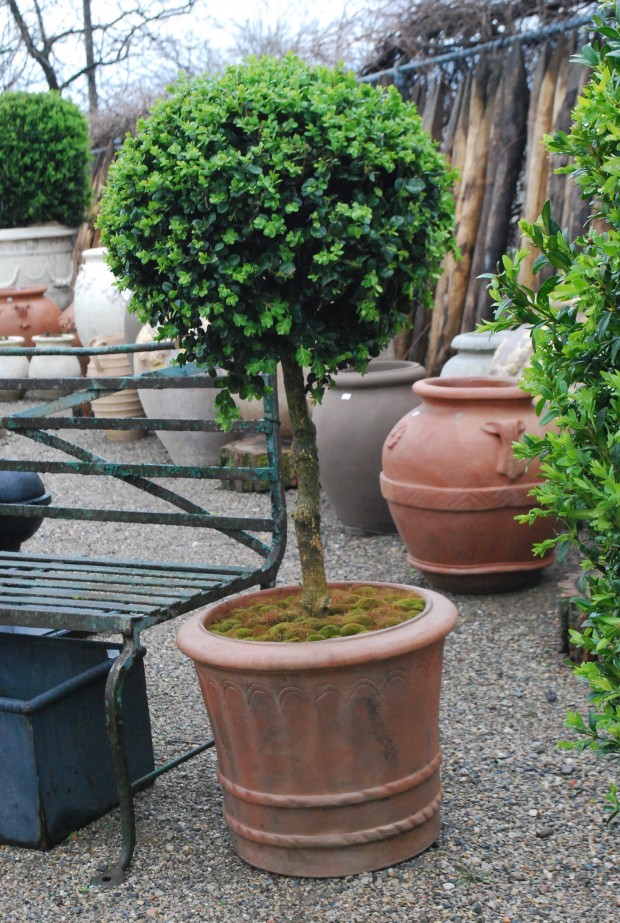 A completely natural and God given landscape-that would be the wild and untouched places in the Upper Peninsula of Michigan. The climax forests. The primeval forests. The roadside weed colonies. What grows out of the tarmac, or next to the railroad tracks. An accident of nature can be the most thrillingly beautiful sight imaginable. Part of why people travel is to experience the natural world-untouched by people- in places all over the earth. An undisturbed stand of birch, a field full of Queen Anne’s Lace, a bog ablaze with marsh marigolds in the spring-all gardening people love these places.
A completely natural and God given landscape-that would be the wild and untouched places in the Upper Peninsula of Michigan. The climax forests. The primeval forests. The roadside weed colonies. What grows out of the tarmac, or next to the railroad tracks. An accident of nature can be the most thrillingly beautiful sight imaginable. Part of why people travel is to experience the natural world-untouched by people- in places all over the earth. An undisturbed stand of birch, a field full of Queen Anne’s Lace, a bog ablaze with marsh marigolds in the spring-all gardening people love these places.
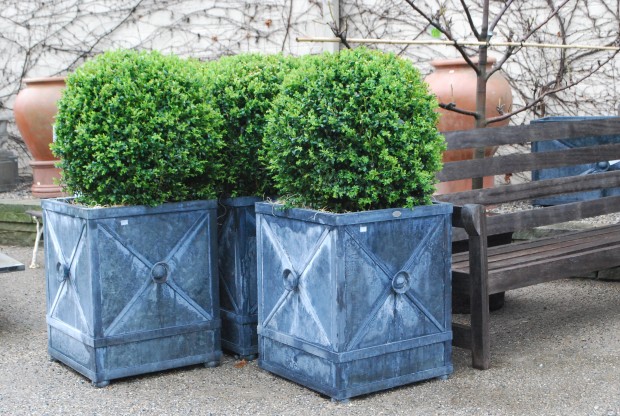 That said, I am at heart, a designer. I favor landscapes that make a statement from the heart, the head, and the hand. People can be heavy handed, but they can also be kind, patient, observing, caring, daring, brilliant, and nurturing. I am interested in the choices gardeners make. I am also very interested in the choices designers make. Choices gardeners make provide for astonishingly different outcomes. Designed landscape spaces are structured. They may be structured around use, and traffic. They may be structured with beauty in mind. They may be structured for a particular season, a favored color, a sense of visual balance, for mystery, for fun, for meditation. They may be structured around a very personal and particular point of view.
That said, I am at heart, a designer. I favor landscapes that make a statement from the heart, the head, and the hand. People can be heavy handed, but they can also be kind, patient, observing, caring, daring, brilliant, and nurturing. I am interested in the choices gardeners make. I am also very interested in the choices designers make. Choices gardeners make provide for astonishingly different outcomes. Designed landscape spaces are structured. They may be structured around use, and traffic. They may be structured with beauty in mind. They may be structured for a particular season, a favored color, a sense of visual balance, for mystery, for fun, for meditation. They may be structured around a very personal and particular point of view.
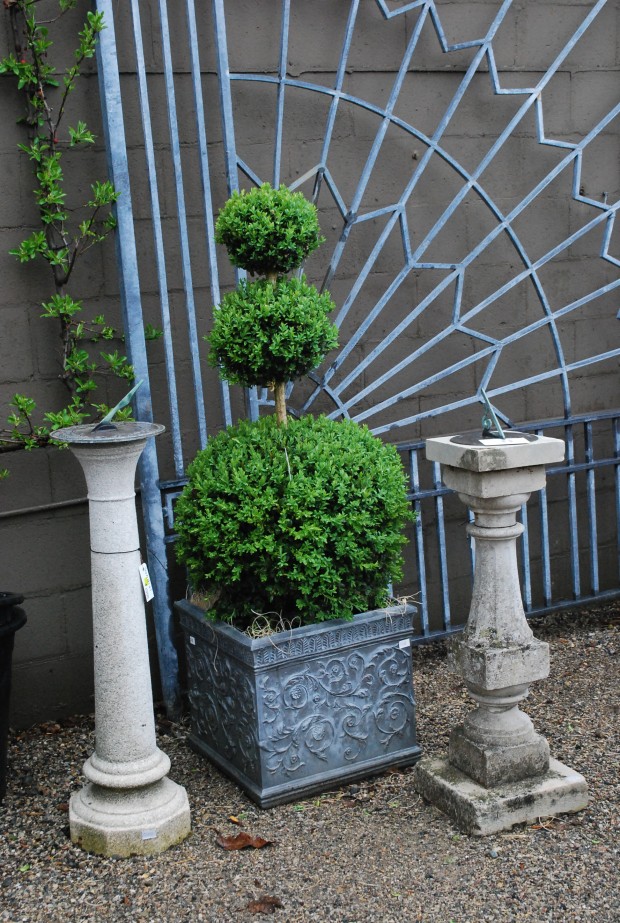 Beautifully structured landscapes transform an idea or thought into a picture. I would explain this idea in this way. Many people could not draw a portrait, but every person is able to recognize the face of an acquaintance or friend. Many people recognize the faces of people they have not seen for years, or people they only know slightly. Visual recognition is a very powerful human attribute. We all have it. Designers appeal to visual recognition. The delight that comes from visual recognition-extraordinary. Design that manages to engage all of the senses is great design.
Beautifully structured landscapes transform an idea or thought into a picture. I would explain this idea in this way. Many people could not draw a portrait, but every person is able to recognize the face of an acquaintance or friend. Many people recognize the faces of people they have not seen for years, or people they only know slightly. Visual recognition is a very powerful human attribute. We all have it. Designers appeal to visual recognition. The delight that comes from visual recognition-extraordinary. Design that manages to engage all of the senses is great design.
 We had a number of boxwood topiaries delivered a few days ago, from a grower on the West Coast. We do not order plants over the phone, sight unseen, via an availability list. Rob flies out there every winter. He walks the fields. He chooses plants that he feels beautifully represents his point of view, as a designer. He discusses the pruning, the care. His buying-incredibly personal.
We had a number of boxwood topiaries delivered a few days ago, from a grower on the West Coast. We do not order plants over the phone, sight unseen, via an availability list. Rob flies out there every winter. He walks the fields. He chooses plants that he feels beautifully represents his point of view, as a designer. He discusses the pruning, the care. His buying-incredibly personal.
 Any great design bears the mark and hand of a client, empowered by the hand of a skilled designer. I will say that the design of my landscapes is primarily about a relationship, forged. A passionate client, and a passionate designer makes for landscapes of note. I feel very confident saying that great landscape design springs from a relationship marked by mutual passion and respect. I have a great respect for the boxwood topiaries that Rob chose to buy. I feel completely confident that should I recommend to client that they invest in an old plant with a history, they will not be disappointed. There is a provenance in which to trust.
Any great design bears the mark and hand of a client, empowered by the hand of a skilled designer. I will say that the design of my landscapes is primarily about a relationship, forged. A passionate client, and a passionate designer makes for landscapes of note. I feel very confident saying that great landscape design springs from a relationship marked by mutual passion and respect. I have a great respect for the boxwood topiaries that Rob chose to buy. I feel completely confident that should I recommend to client that they invest in an old plant with a history, they will not be disappointed. There is a provenance in which to trust.
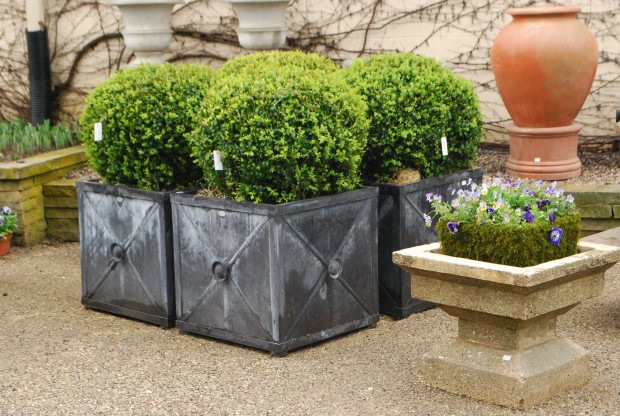 The intense rain this afternoon-so great for these newly relocated plants. The new growth is glowing. My clients who asked that I draw the locations for 100 boxwood in pots in his landscape-this post is dedicated to them.
The intense rain this afternoon-so great for these newly relocated plants. The new growth is glowing. My clients who asked that I draw the locations for 100 boxwood in pots in his landscape-this post is dedicated to them.
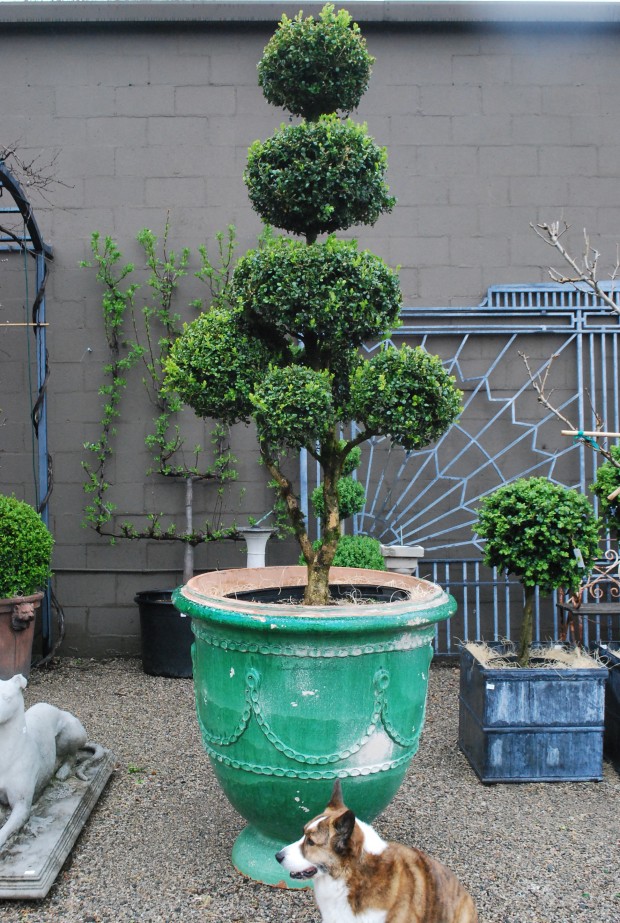 This boxwood topiary-astonishing in its age and size. Rob tells me it reminded him of Thomas Church. I can see why he fell for it. There is the sure evidence of a patient, committed, and loving hand. We make extraordinary plants like this one available to gardeners. But more than that, we design.
This boxwood topiary-astonishing in its age and size. Rob tells me it reminded him of Thomas Church. I can see why he fell for it. There is the sure evidence of a patient, committed, and loving hand. We make extraordinary plants like this one available to gardeners. But more than that, we design.
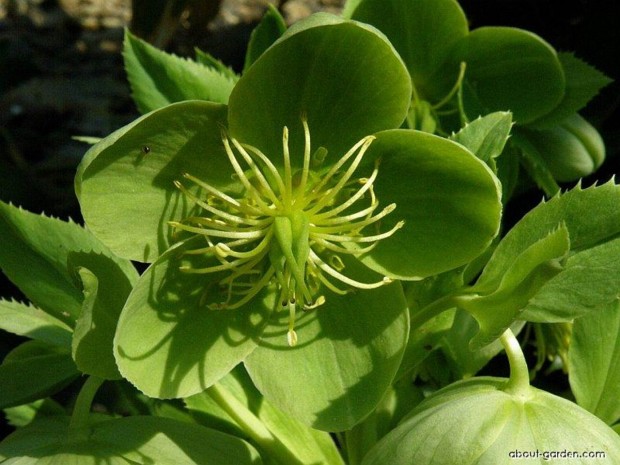 The herbaceous perennial helleborus is represented by 20 or so species. It is a member of the ranunculus family. This incredible picture of a flower of Helleborus Corsicus, from about-garden.com, tells the tale. Hellebore flowers are comprised of 5 sepals, which persist in fruit. The fact that hellebores emerge from the ground and bloom very early in our gardening year is plenty enough reason to grow them. But the fact that the 5 sepals hang on for months-during and after the time that the flower sets seed-is even more compelling. The lustrous green foliage grows vigorously, and persists in my garden throughout the winter. My plants are virtually care free. They get sun, adequate moisture, and are protected from winter winds by an old stand of dwarf spruce-picea mucrunulatum. I have never divided them, nor do I feed them. I do spend plenty of time looking at them-they are that good looking.
The herbaceous perennial helleborus is represented by 20 or so species. It is a member of the ranunculus family. This incredible picture of a flower of Helleborus Corsicus, from about-garden.com, tells the tale. Hellebore flowers are comprised of 5 sepals, which persist in fruit. The fact that hellebores emerge from the ground and bloom very early in our gardening year is plenty enough reason to grow them. But the fact that the 5 sepals hang on for months-during and after the time that the flower sets seed-is even more compelling. The lustrous green foliage grows vigorously, and persists in my garden throughout the winter. My plants are virtually care free. They get sun, adequate moisture, and are protected from winter winds by an old stand of dwarf spruce-picea mucrunulatum. I have never divided them, nor do I feed them. I do spend plenty of time looking at them-they are that good looking.
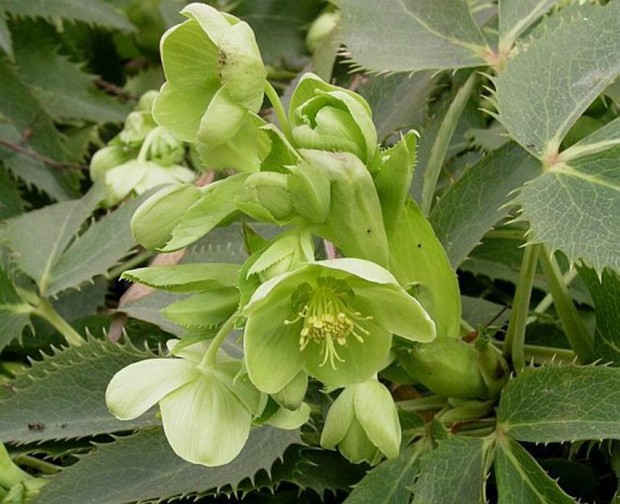 I had a mind to grow helleborus argutifolius, as I am very fond of green flowers. This species grows quite tall, and features shiny and spiny leaves. I had no idea at the time that hellebores are divided into 2 groups-those that bloom on the leaf stalks like helleborus argutifolius, and those whose leafless flower stalks emerge from the ground in the spring. I was never successful with this hellebore-the Michigan winters invariably rotted the buds before they could open in the spring. I finally ripped them all out, in favor of those hellebores whose flowers were kept safely below ground until the freezing winter weather had passed.
I had a mind to grow helleborus argutifolius, as I am very fond of green flowers. This species grows quite tall, and features shiny and spiny leaves. I had no idea at the time that hellebores are divided into 2 groups-those that bloom on the leaf stalks like helleborus argutifolius, and those whose leafless flower stalks emerge from the ground in the spring. I was never successful with this hellebore-the Michigan winters invariably rotted the buds before they could open in the spring. I finally ripped them all out, in favor of those hellebores whose flowers were kept safely below ground until the freezing winter weather had passed.
 Helleborus viridis is fairly uncommon in the garden. It is usually the darkest green, and the shortest of the green hellebores. You can find excellent photographs and descriptions via Graham Rice. http://www.grahamrice.com/hellebore/species/viridis/
Helleborus viridis is fairly uncommon in the garden. It is usually the darkest green, and the shortest of the green hellebores. You can find excellent photographs and descriptions via Graham Rice. http://www.grahamrice.com/hellebore/species/viridis/
Helleborus orientalis has in recent years been the subject of considerable hybridization. You can find beautiful green hellebores for sale at Carolyn’s Shade Garden, Pine Knot Farms, Plant Delights Nursery, Fraser’s Thimble Farms and Arrowhead Alpines. If you love green flowers, and perennial plants that are beautiful the entire season long, try some green hellebores. To follow is a collection of pictures that will give an idea of wide a range of green flowering cultivars are available.
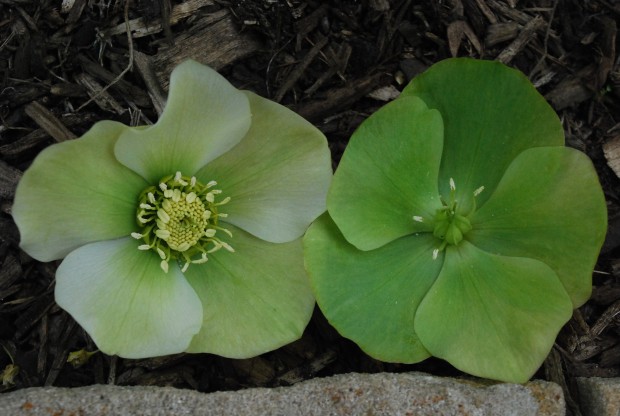 This picture from my own garden shows the flower in full bloom on the left, and the sepals still intact on a flower from the same plant on the right.
This picture from my own garden shows the flower in full bloom on the left, and the sepals still intact on a flower from the same plant on the right.
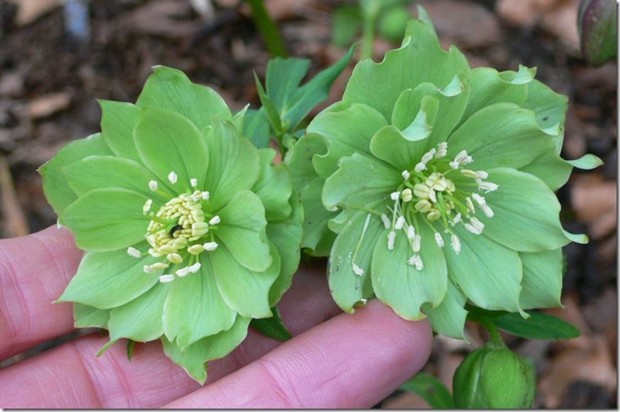 Many of these pictures come from hellebores.org – an excellent reference, if you are looking for more information.
Many of these pictures come from hellebores.org – an excellent reference, if you are looking for more information.
 This photo is from dailymail.co.uk. My hellebores at home are just beginning to throw their flower stalks. The next month will be such fun-watching them develop.
This photo is from dailymail.co.uk. My hellebores at home are just beginning to throw their flower stalks. The next month will be such fun-watching them develop.
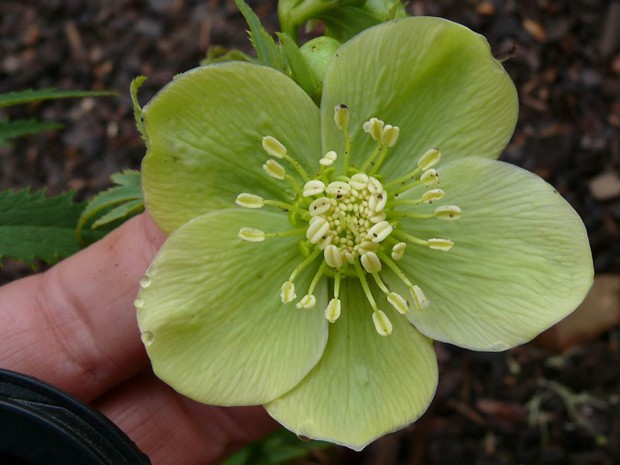 These flowers are incredibly beautiful. Looking fore a plant that is worth all of your love and then some? Try a hellebore.
These flowers are incredibly beautiful. Looking fore a plant that is worth all of your love and then some? Try a hellebore.
My enchantment with plants dates back so long I can hardly remember how it started. To the best of my recollection, a brief residence in North Carolina after I graduated from college got me interested in orchids. Who knows what prompted that. A plant at the grocery store checkout counter-it could have been. Within just a few months, I was spending more on orchids than groceries. My rental house in Chapel Hill had orchids in pots and on boards hanging from the trees. The mild climate made it easy to cultivate them outdoors. The slipper orchids-loved them. Who knows why or how, but I became intensely interested in plants. All of a sudden, I was noticing them everywhere. In parking lots, and in residential yards. In buildings. In wild places, left to their own devices. What was growing behind the garage, or at the ocean shore. The plants-loved each and every one of them.
The moment that I became aware of plants was not a momentous day. Just an ordinary moment. But in the years since, I can see that the life of the plants has altered and greatly influenced the course of my life. Wildflowers. trees. tree peonies. rock garden plants. herbaceous perennials hardy in my zone. the annuals that live but one season. Ferns. Dahlias. Woody shrubs. herbs. evergreens. succulents. vegetables. bulbs, espaliers. moss and lichens. Tropical plants. The plant kingdom-the organizing metaphor, the language upon which a landscape or garden design is built. Why am I thinking about this? Our spring fair opened yesterday. 10 growers brought their spring plants to exhibit and sell. We moved our fair inside-the cold, blustery, and snowy weather was so terrible. As much as I hated to host a spring fair when fair spring weather was not in the forecast, I was ready for a spring celebration. Lots of other people were ready for spring too-notwithstanding the current cold and gray.
As reluctant as I was to move the growers with their plants inside our shop, they were pleased. And the many hundreds of people who came today were happy for a venue indoors too. Our warehouse style garage was packed with people all day long-looking at the plants. I was astonished to hear the general consensus from all of the growers in attendance. We like being indoors, in close quarters. The feeling-community-like. I personally observed gardeners in that garage for hours-looking over the plants. They were dry, warm, and comfortable. They had lots of company. Why should I be surprised? It is the plants- around which no end of different people express their delight and connection with the natural world. There was a lot of talk. A lot of looking. A lot of exchange. I feel certain, after a Saturday that was jam packed from start to finish, this spring fair was above all, about the plants.
I had lots of confirmation today that there is an instinct in people to make something grow. Better than that-a love for making something grow. People who had never met before, were deep in conversation, and making notes. Over the plants. The peonies from Wiegands and the hellebores from Arrowhead Alpines-sold out. The wildflowers from Starr Foster-all but gone. I was so worried about the weather for our fair. Tonight I realize that the gardening people and the plants made the weather a side story. The main attraction? Making something grow.
Deborah Silver is a landscape and garden designer whose firm, Deborah Silver and Co Inc, opened its doors in 1986. She opened Detroit Garden Works, a retail store devoted to fine and unusual garden ornament and specialty plants, in 1996. In 2004, she opened the Branch studio, a subsidiary of the landscape company which designs and manufactures garden ornament in a variety of media. Though her formal education is in English literature and biology, she worked as a fine artist in watercolor and pastel from 1972-1983. A job in a nursery, to help support herself as an artist in the early 80’s evolved into a career in landscape and garden design. Her landscape design and installation projects combine a thorough knowledge of horticulture with an artist’s eye for design. Her three companies provide a wide range of products and services to the serious gardener. She has been writing this journal style blog since April of 2009.
Copyright © 2024 · Deborah Silver & Co. · Detroit Garden Works